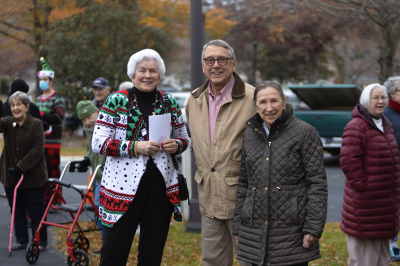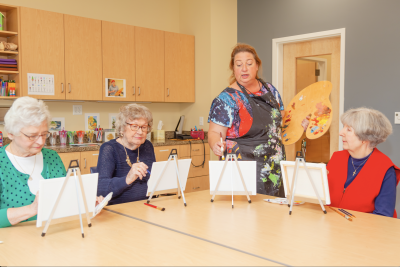 It is a busy time of year for many as calendars are filled with holiday parties and family gatherings. But for some, particularly retirees living alone, this season puts a painful exclamation point on the loneliness and social isolation they must endure year-round. With study after study showing the detrimental effects being lonely and secluded can have on health, should easy-access to social connection be added to the list of benefits of retirement communities?
It is a busy time of year for many as calendars are filled with holiday parties and family gatherings. But for some, particularly retirees living alone, this season puts a painful exclamation point on the loneliness and social isolation they must endure year-round. With study after study showing the detrimental effects being lonely and secluded can have on health, should easy-access to social connection be added to the list of benefits of retirement communities?
Social isolation may impact mental, physical health
We’ve written before about the negative consequences of loneliness and social isolation. It’s a common issue among older people that was only worsened over the years — particularly during the pandemic.
A January 2023 National Poll on Healthy Aging (NPHA) of 2,563 adults age 50 to 80 explored participants’ social interactions and any feelings of isolation. The NPHA research team at the University of Michigan’s Institute for Healthcare Policy and Innovation had polled a similar sample set, asking the same questions in 2018, 2020, 2021, and 2022.
Among the findings from the most recent poll:
- 34% of 2023 poll’s respondents said they sometimes or often feel isolated from others — 25% more than the 27% who reported these feelings in 2018.
- 37% of respondents said they had felt a lack of companionship in the past year — up from 34% in 2018.
- 33% of poll respondents said they infrequently (once a week or less) have social contact with family they don’t live with, friends, or neighbors — higher than the 28% who noted this in the 2018 poll.
The 2023 NPHA poll also found there is a correlation between older people’s feelings of social isolation and loneliness and poorer mental and physical health.
- Respondents who described their mental health as fair or poor were more than twice as likely to feel a lack of companionship (73%) as those who said their mental health was excellent, very good, or good (33%).
- 77% of people who reported their mental health was fair/poor said they sometimes or often felt socially isolated, versus just 29% of those who said they had good-to-excellent mental health.
- 56% of people reporting fair/poor mental health said they had infrequent social contact as compared to just 30% of those with better mental health.
- 55% of those in poorer physical health said they were sometimes or often socially isolated compared to just 29% of those with good to excellent physical health.
- Similarly, 55% of the poorer physical health group reported feeling a lack of companionship and loneliness versus only 33% of those people in better physical health.
Which is the causative factor?
Looking at these 2023 NPHA results, it can be difficult to know if this is a chicken or egg scenario. Data gathered in a poll is basically a snapshot in time. Are the people in the NPHA poll who reported being in poorer mental and physical health in that condition because they are feeling socially isolated and lonely, or are they isolated and alone because they are in poorer health?
Julianne Holt-Lunstad, Ph.D., a psychology professor at Brigham Young University, has conducted research on the health effects of loneliness and poor social support, and has found sometimes-deadly consequences in the form of early mortality. In fact, Dr. Lunstad warns that “evidence suggests that lacking social connection contributes to earlier death to a similar magnitude as many other traditional risk factors — including smoking up to 15 cigarettes per day.”
While research like Dr. Holt-Lunstad’s and the NPHA has examined the connection between loneliness and health detriments, and even early mortality, recent research out of the U.K. delves further into the compounding nature of various elements of being lonely.
 Social connection tied to longevity
Social connection tied to longevity
Since 2006, the U.K. Biobank has been collecting ongoing biological and medical data on half a million people between the ages of 40 and 69 who live in the U.K. — a tremendous sample size. Researchers from the School of Health and Wellbeing of the University of Glasgow in Scotland analyzed datasets from 458,146 people in the U.K. Biobank to “examine the independent and combined associations between functional and structural components of social connection and mortality.”
Social connection was assessed using two functional measures and three structural ones:
Functional (sense of loneliness)
- Frequency of ability to confide in someone close
- Often feeling lonely
Structural (sense of isolation)
- Frequency of friends/family visits
- Weekly group activities
- Living alone
The researchers found that experiencing a lack of any of these five types of social connection — to any degree — was associated with a higher risk of dying early from any cause. Delving deeper, they found the risk of premature death for those who lived alone and never had visits increased by 39% over those whose friends and family visited them daily.
One of the unexpected benefits of retirement communities?
Interestingly, the University of Glasgow researchers discovered that engaging in group activities with non-loved ones did not reduce this risk of earlier death, whereas spending time with loved ones did. This finding suggests that interacting with friends and family may be more protective to your health than mere surface-level interactions with random people.
Perhaps this benefit to wellbeing is attributable to the support — emotional and/or physical — that loved ones are able to provide. Or maybe the health benefit stems from loved one’s ability to recognize subtle changes in an older person’s health and encourage any necessary interventions. Either way, the connection between time spent with beloved friends and family and a lower risk of early mortality cannot be ignored.
Should this correlation be added to the list of potential benefits of retirement communities? It might be a somewhat unforeseen perk, but it should be a consideration in your senior living decision, nonetheless.
Once a resident is settled into a retirement community, it is common for neighbors to evolve into dear friends. (In some cases, lifelong friends even coordinate their moves to the same 55-plus community.) These connections not only bolster the sense of camaraderie felt by residents, the also provide convenient access to fun social opportunities for the good times …and a solid support system for life’s challenges. Even if a person’s mobility declines, the proximity of close friends within a 55-plus community can be invaluable to a person’s mental and physical wellbeing.
When you add this accessibility to social-emotional connections (and their potential boost to longevity) to the many other benefits of retirement communities (low- or no-maintenance, amenities like pools and dining, and in some cases, access to on-site care services, if needed — to name just a few), it is easy to understand retirement communities’ appeal for some people.
Reprinted with permission by myLifeSite
